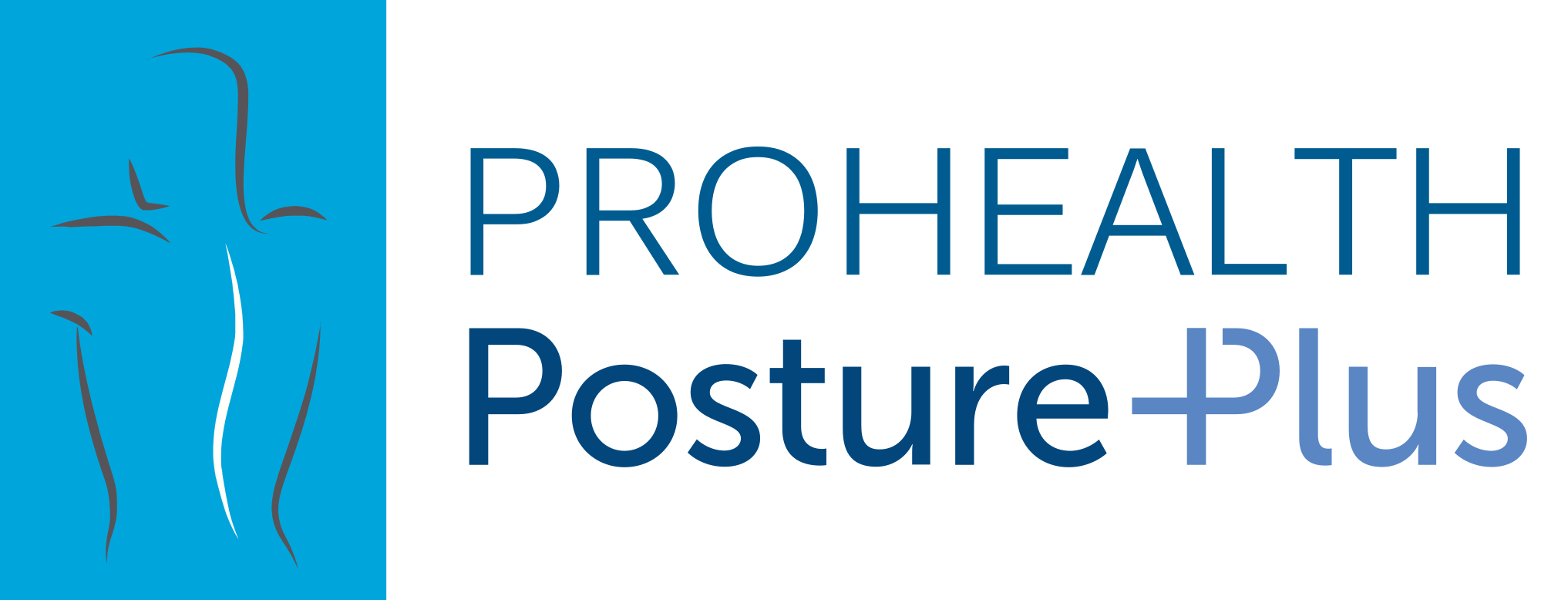
Common Shoulder Injuries in Dragon Boating
Shoulder injuries and shoulder pain are common occurrences in sports, but particularly in dragon boating. With Hong Kong attracting hundreds of international and local teams with a series of events and races during the summer, dragon boating is undoubtedly a fiercely competitive event in the region.
Dragon boating paddling requires a great amount of coordination, flexibility, power, timing, good anaerobic capacity, aerobic endurance, a high level of technical competency and teamwork. The paddling motion can place high loads on the shoulder and lower back, thus making these areas vulnerable to overuse injury. Dragon boaters frequently suffer from shoulder ailments due to the constant overhead motions required for paddling. These injuries range from minor sprains to more severe disorders such as bursitis, impingement syndrome, and torn rotator cuffs.
Let’s explore the most common types of shoulder injuries, the risk factors that contribute to their development, and the physiotherapy treatment options available for managing these conditions. We hope that this information will help you make informed decisions about your fitness routines and understand how to prevent and manage shoulder injuries.
What Are The Most Common Shoulder Injuries?
The most common shoulder injuries we treat range from minor sprains to more severe disorders such as bursitis, impingement syndrome, and torn rotator cuffs.

Shoulder injuries are often caused by overuse, improper technique, or a combination. In dragon boat racing, the repetitive motion of paddling can put much stress on the shoulder joint, leading to injuries such as:
Rotator Cuff Injuries
A rotator cuff is a group of muscles and tendons surrounding the shoulder joint, helping keep the arm bone connected to the socket. Rotator cuff injuries can occur when these muscles and tendons are overused or torn, causing pain, weakness and limited mobility in the shoulder.
Shoulder Impingement
Shoulder impingement occurs when the tendons in the shoulder joint become pinched or compressed, causing pain and inflammation.
Bursitis
Bursitis is the inflammation of bursae, which are small sacs of fluid that cushions the bones, tendons and muscles around the joint. Bursitis can cause pain, swelling, and stiffness in the shoulder. Bursitis is usually a result of repetitive motion or overuse of the joint.
Rotator cuff injuries, shoulder impingement, and bursitis can all cause shoulder pain and discomfort, but they involve different structures within the shoulder joint. Diagnosis of these conditions is typically made by a physiotherapist through a physical examination, medical history, and imaging tests such as X-rays, ultrasound, or MRI scans.
Getting medical help if you’re having shoulder pain or discomfort is crucial as taking precautions against future damage. Physiotherapy is a highly efficient method for achieving this. Let’s take a look at how physiotherapy may treat shoulder injuries and offer advice on avoiding them altogether.
Physiotherapy’s Role in Treating Shoulder Injuries
Physiotherapy can evaluate the shoulder injury and provide a personalised recovery plan for you – a highly efficient and non-invasive method understanding the root cause of the injury and ultimately, providing the most appropriate treatment.
Your physiotherapist may suggest relative rest and tell you to avoid overhead activities. Physiotherapy will focus on reducing your pain, stretching any shortened muscle groups and strengthening weak muscle groups to allow you to return to normal activities as soon as possible.
The most common physiotherapy treatments for shoulder injuries include:
Pain Relief Treatments
A physiotherapist can assist with pain relief and inflammation in the shoulder by employing a variety of treatments such as massage therapy, heat therapy, and ultrasound. These treatments are highly targeted to the affected areas and provides faster pain relief and recovery.
Manual Therapy
To help increase the mobility of the shoulder joint, a physiotherapist might utilise hands-on physiotherapy methods such as joint mobilization and manipulation. The purpose of manual therapy is to physically affect the joints to:
- Reduce stiffness
- Increase range of movement
- Reduce pain
Our physiotherapists demonstrate some of the methods and therapies he uses for treating shoulder conditions, including joint mobilization as well as instrument assisted soft tissue mobilization (IASTM).
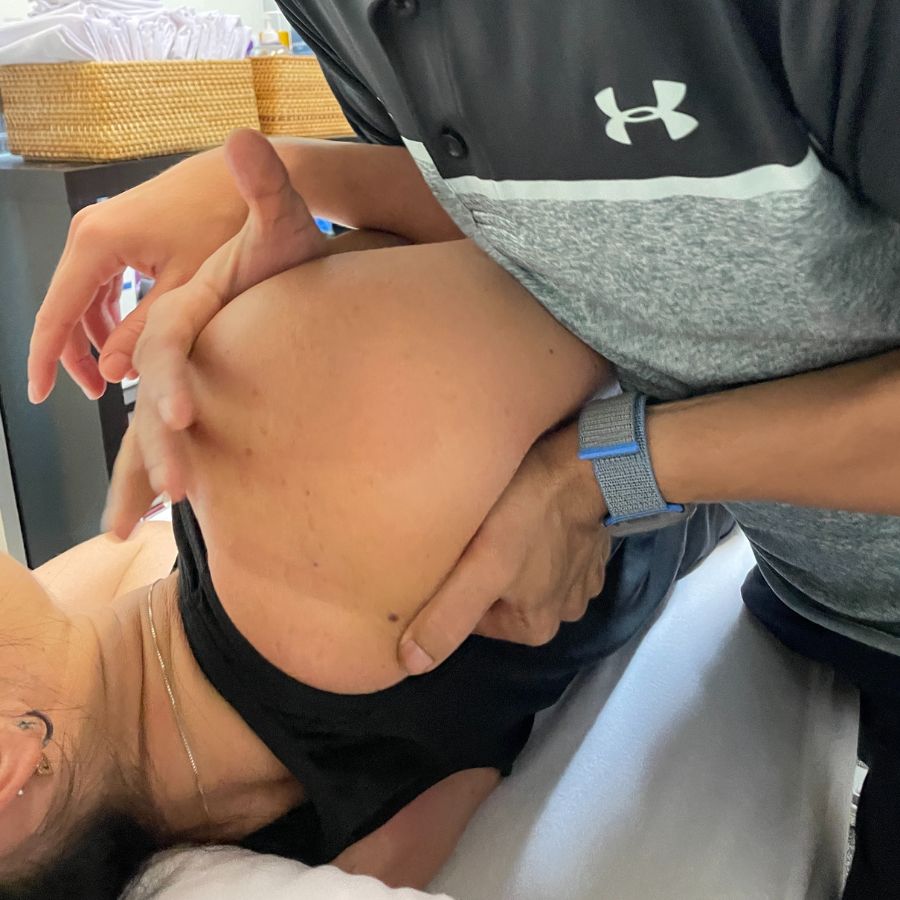
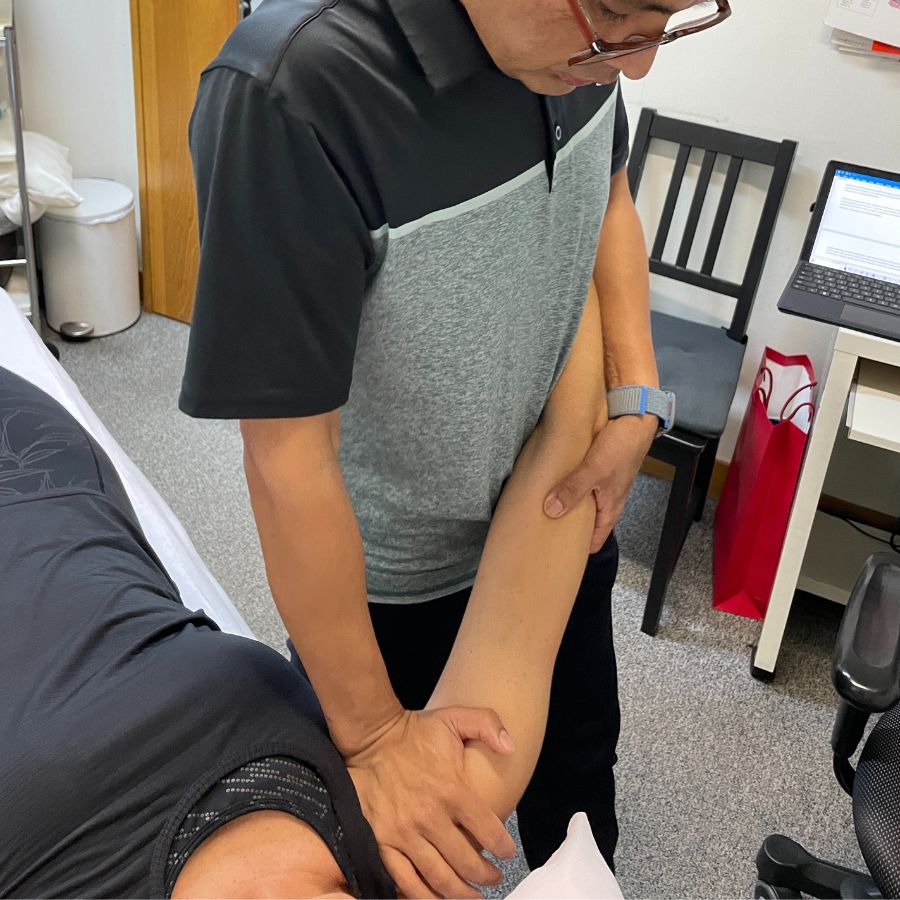
Acupuncture & Dry Needling
Acupuncture and dry needling can be useful tools in physiotherapy treatments of shoulder injuries.
Acupuncture involves the insertion of fine needles into specific points, to stimulate the release of endorphins and other natural pain-relieving chemicals. This can help to alleviate pain and discomfort in the shoulder and promote relaxation of the surrounding muscles. Additionally, acupuncture can improve circulation, which can help to reduce inflammation and promote healing.
Dry needling, involves the insertion of needles into trigger points in the muscles around the affected joint. Dry needling is particularly effective in treating soft tissue injuries and trigger points. This can help to release tension and improve range of motion in the joint. This can be particularly beneficial in cases where the muscles around the shoulder joint have become tight or restricted due to injury or overuse.
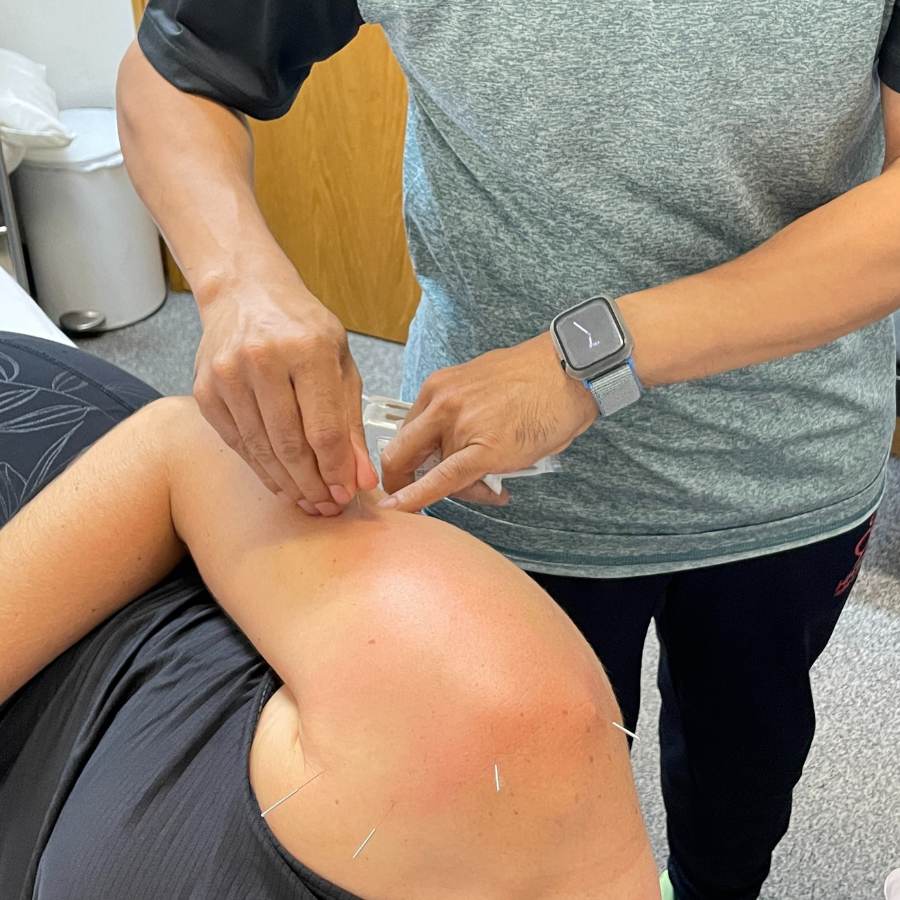
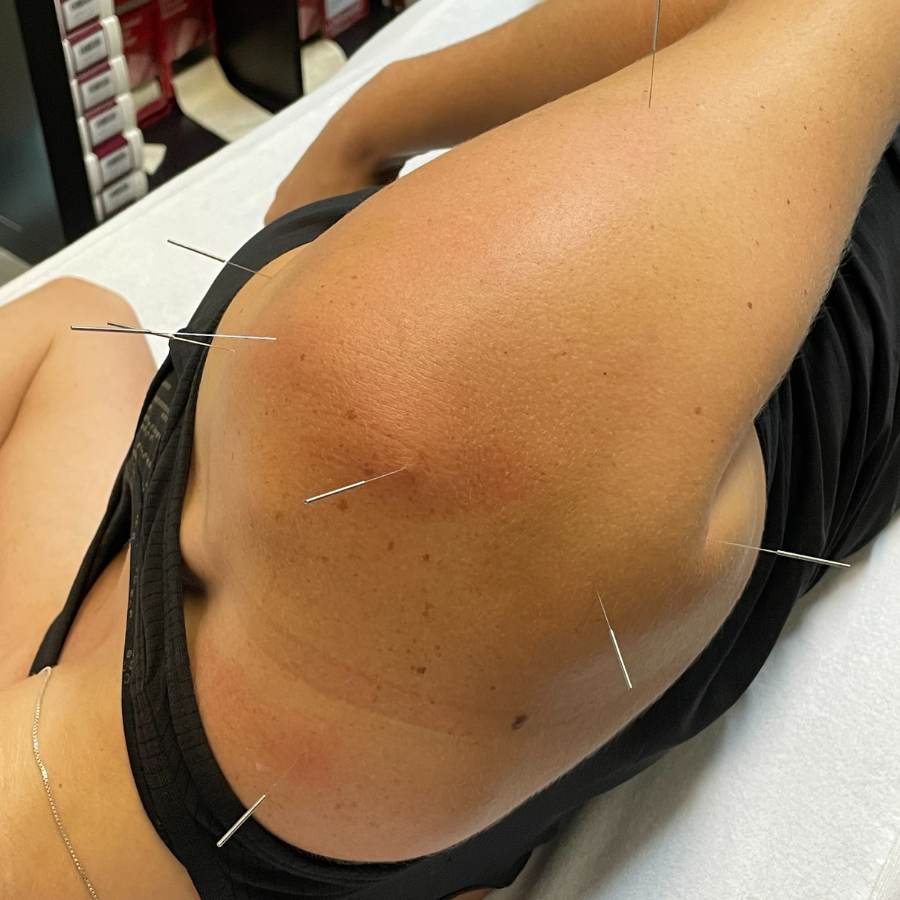
Exercises (Strengthening and Mobility)
To help the shoulder injury heal, your physiotherapist may prescribe exercises that are designed to strengthen the muscles around the shoulder joint to enhance overall shoulder stability. A physiotherapist can also prescribe and teach you stretches and exercises that are designed to increase your range of motion.
Not only does exercise-based rehabilitation improve the shoulder’s strength and mobility, it also promotes the healing process, breaks down scar tissue and reduces pain.
In the next section below, we share 5 effective shoulder exercises to improve shoulder strength and aid in recovery.
Patient Education
While the physiotherapy treatments listed above are designed to directly treat the shoulder injury, the last piece of the puzzle is to educate our clients so that they can practice good posture and paddling techniques to minimise the risk of re-injury in the feature. By providing expert and relevant education to the patient based on their situation and lifestyle, they can confidently manage their own health after receiving the physiotherapy treatments
5 Exercises to Improve Shoulder Strength & Recovery
Here, we share 5 exercises that are great for improving your shoulder strength and range of motion. In general, when practicing these exercises, aim to do them for 10-15 repetitions for 3 sets.
Twisting Wall Press for Shoulder Impingement
This exercise is effective for developing good control and stability in the shoulders, while also opening the chest and the thoracic spine. It will work your rotator cuff muscles at their end range, with the shoulder abducted horizontally.
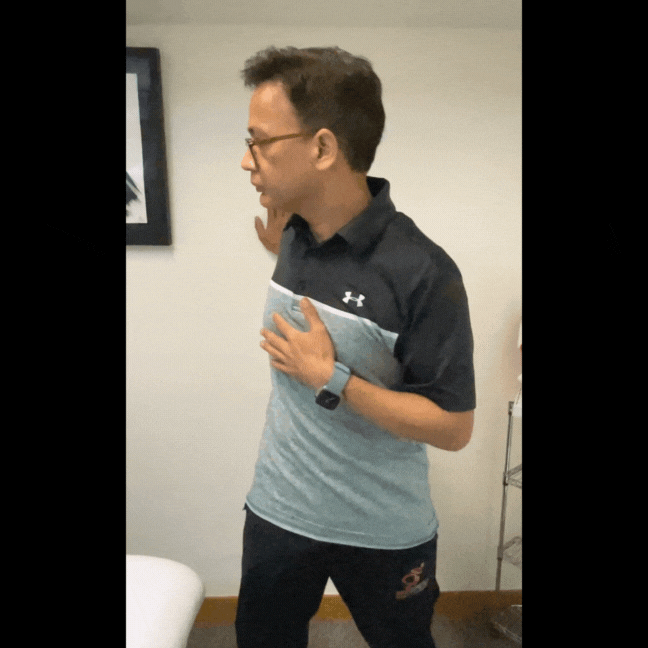
- Stand facing away from a wall with your feet shoulder width apart
- Rotate to the right and place your right hand flat on the wall
- Bend into your elbow as you lean toward the wall
- Press into the wall to re-straighten your arm and push your body away from the wall
- Return to the starting position
- Repeat the motion on the opposite side, rotating towards the left
- Complete 4-8 reps per side
When doing this exercise, try to keep your hips square the entire time. This will help improve your rotational mobility through both the hips and the spine.
Horizontal Shoulder Mobilization #1
This shoulder mobilization exercise has numerous benefits for the shoulder joint. First of all, it provides decompression and encourage blood flow. This exercise also helps you build up control of the scapula (also known as the shoulder blade) in multiple ranges, This contributes to boosting the stability and mobility of the shoulder as a whole.
To practice this exercise, you’ll need to set up a band between head and chest height. You can use a resistance band or a theraband to perform this exercise. Make sure to use a resistance band that provides enough tension for you to complete 3 sets of 10-15 repetitions per exercise.
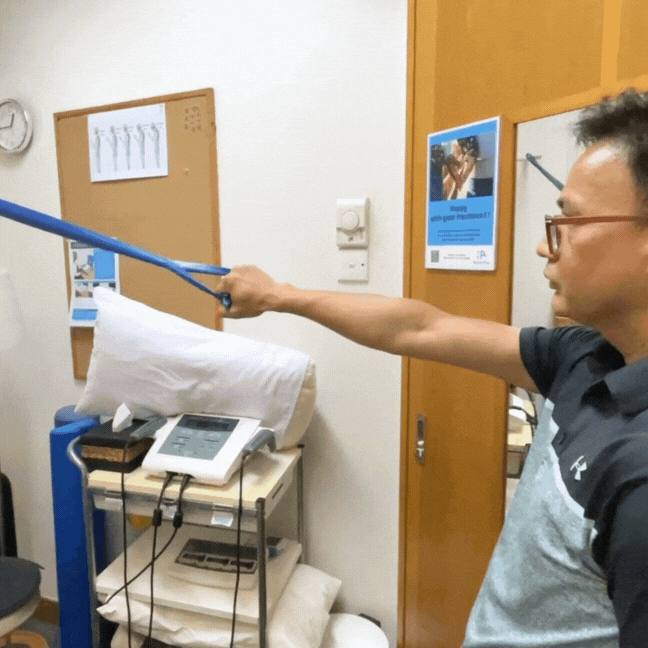
- Raise your arm out in front of you
- Protract your scapula (move your scapula forward) without rotating the body or shrugging the shoulders
- Internally rotate the shoulder by focusing on rotating your elbow
- Hold at your end range for 2 seconds, then externally rotate the shoulder and hold
- Repeat this 3 times before switching arms
Horizontal Shoulder Mobilization #2

Another variation is to turn your body sideways, so that the arm performing the exercise is perpendicular to your body.
- Face the opposite direction so that the arm attached to the band is crossing in front of your body
- Keep your shoulder depressed and if possible, your elbow straight
- Protract your scapula to reach the arm toward the band slightly and complete 3 rotation cycles
- Retract and repeat before switching arms and sides
Lasso Exercise for Rotator Cuff
This move incorporates Proprioceptive Neuromuscular Facilitation (PNF) techniques as it moves your rotator cuff muscles through rhythmic contract-relax phases.
By utilizing this move, you’ll not only improve your shoulder’s capabilities for rhythmic stabilization, you’ll also improve your ability to maintain good posture.

- Tie a rope around a ring or wrap a tennis ball in a hand towel and tie a string or rope securely around it
- Grip the rope about a foot and a half back from the ring or ball
- Stand in a neutral position with shoulders back
- Keep your right elbow in by your body as you start to swing the rope in a clockwise direction
- Swing the rope to make circles in front of your body, focusing on using your shoulder to swing
- Swing for 30-60 seconds
- Switch to swing with the left arm for 30-60 seconds (swinging counter-clockwise now)
Reverse Fly for Rotator Cuff
This exercise will work the rear deltoids muscles, as well as the four rotator cuff muscles. 8-15 reps of the movement 2-3 sets of each movement Only do as many as is comfortable, because you definitely don’t want to push the shoulder too far, and risk further rotator cuff injury.
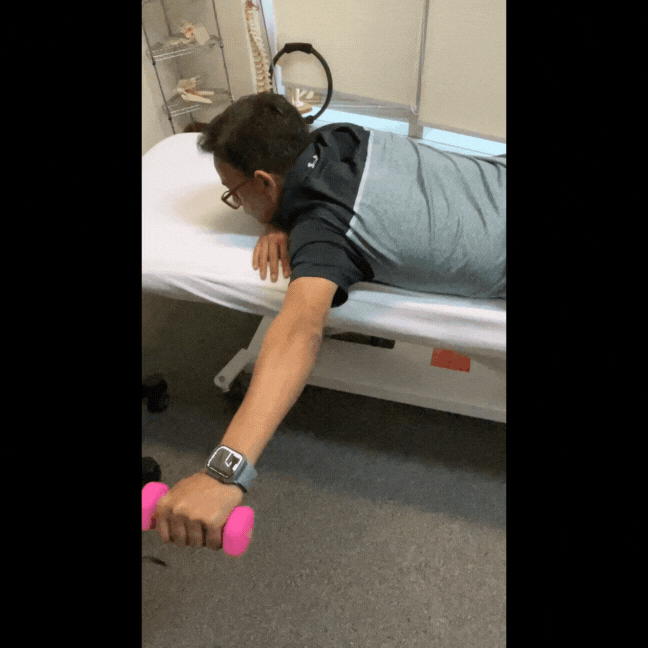
- Lie face down on a bed with your arm extended straight out to the sides, palms facing down
- Holding a light dumbbell, squeeze your shoulder blades together and lift your arm to the side until it reaches shoulder height.
- Hold the contraction for a moment, then slowly lower the arm back down to the starting position
- Repeat for the desired number of repetitions.
- Make sure to keep your neck and spine in a neutral position
Wall Slides

- Standing a few feet from a wall, place both palms flat against the wall at shoulder height. Keep your hips and feet parallel with each other.
- Your knees can be bent or straight. (Straighter legs will increase the stretch through the lower body)
- Inhale and slowly extend your arms up the well. Exhale and press your chest and shoulders forward towards the wall/floor.
- To increase the stretch, press back into the thighs, remembering to not collapse into the low back.
- Move your arms back down and return to the original position
This pose can also be done seated! This might be more ideal for you if you are in your third trimester to best support your hips and reduce pressure in the lower part of your spine.
Best Tips on Preventing Shoulder Injuries
Here are some recommendations for avoiding shoulder injuries during dragon boating because prevention is always preferable to treatment:
Warm Up PROPERLY!
Before you begin paddling, make sure you gently stretch and strengthen your shoulder muscles
Always Practice Good Technique When Paddling
Avoiding shoulder injuries requires using a good paddling technique. Aim to produce power using your torso rather than just your arms 3. Take breaks: Rest your shoulder muscles by paddling less if you feel tired or sore.
Build Up Your Shoulder Muscles to Prevent Injuries
Strengthening your shoulder muscles can shield you from harm, as weakness in the muscles can often lead to a higher risk of injury. Consider adding shoulder strengthening drills in your daily exercise program.
Always Listen To Your Body
If you begin to experience shoulder pain or discomfort, don’t dismiss it. Get medical help and take action to stop additional harm.
Need Any Help? Reach Out to Us!
If you have been struggling with shoulder pain or injuries and would like further advice on treatment and rehabilitation, feel free to reach out to us! Our experienced physiotherapists at Posture Plus offer hands-on treatments for shoulder conditions, as well as a variety of other injuries & conditions that affect the musculoskeletal and neural systems.
Equally, if you are thinking about picking up dragon boating, or any other sport as a new hobby/exercise regimen, you can contact your physiotherapist to arrange a posture and core stability assessment and rehabilitation programme, where we can assess your current strength & mobility and determine the best approach to start your training.
Our team of physiotherapists are professional and experienced in working with clients of all ages and treatments are always personalised to their recovery needs. Working with our physios, you will receive a detailed assessment to fully understand the root cause and identify areas requiring treatment. From there, we then develop a program to help clients return to full mobility and function, with advice on exercises and activities to minimise the risk of re-injury.
References
1. McHardy, A., Pollard, H., & Luo, K. (2007). Golf and upper limb injuries: a summary and review of the literature. Chiropractic & osteopathy, 15, 5. https://doi.org/10.1186/1746-1340-15-5
2. Placzek, J. D., Roubal, P. J., Freeman, D. C., & Kulig, K. (2002). Shoulder rehabilitation strategies, guidelines, and practice. Journal of Hand Therapy, 15(2), 125-141. https://doi.org/10.1016/S0894-1130(02)70030-1
3. Reinold, M. M., Wilk, K. E., & Andrews, J. R. (2009). Current concepts in the evaluation and treatment of the shoulder in overhead-throwing athletes, part 2: injury prevention and treatment. Sports health, 1(2), 132-146. https://doi.org/10.1177/1941738109334216
4. Shah, A., & Buschbacher, R. M. (2011). Upper extremity injuries in rowing: a review. Sports Health, 3(4), 375-380. https://doi.org/10.1177/1941738111403126
Leave a reply